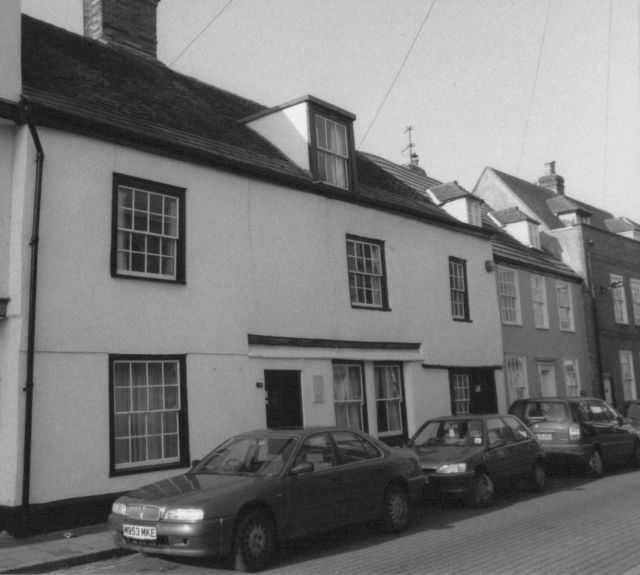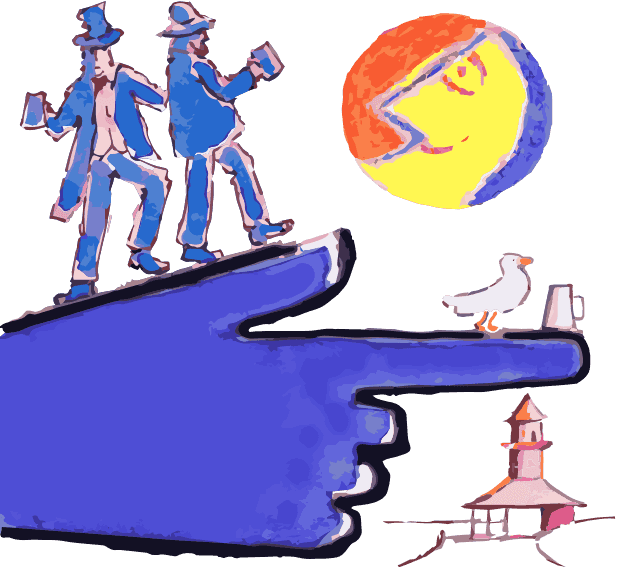The Swan
| Status: | Bed and breakfast rooms with public bar. Check website for availability. |
| Phone: | 01255 502286 |
| Website: | www.swanharwich.co.uk |
The Swan (confusingly also known as the New Swan and the Old Swan) at 14 King's Head Street closed as a public house in 1910 and after periods as a shop and an art gallery it is now a private dwelling with bed and breakfast and a public bar.

History
The Swan seems to date from the 15th Century but like many buildings in Harwich it has been altered in every century since.
It probably started life as a wealthy merchant's house but there is uncertainty about when it turned into a public house - the site is frequently associated with the Bell & Dragon which certainly goes back to the beginning of the 18th Century and probably further as an established “sign” in Harwich.
The Bell & Dragon was certainly an important public house and we know that it had a six-barrel brewery on site capable of producing over 5000 pints of beer a week so it is reasonable to assume that other outlets were being supplied.
In 1743 the brewing and pub scene in Harwich changes fundamentally because Thomas Cobbold decides to move his main brewing operation to Ipswich and, at the same time, seems to take over the Bell & Dragon and close down its brewery, giving him very significant control on beer supply in Harwich. It isn't quite clear how Thomas Cobbold made this decisive move but there is no mention of the Bell & Dragon after 1743.
The Swan has also been linked with the Sign of the Ship and although there is a Ship trading in the late 18th Century in Harwich it overlaps with the Swan which appears around 1790. The problem we have though is that there is a good evidence for the Swan of that time being in King's Quay Street as opposed to King's Head Street. The Swan was owned by one Robert Trotman, an Ipswich brewer, and the landlord was John Leabon.
By 1828 the Swan and the Golden Lion were owned by the defunct Ipswich brewery of Studd, Halliday and Acton and although both pubs probably sold at auction they then simultaneously lost their licences in a controversial move as the Corporation decided to reduce the licensed premises in the town. The controversial part was that the very members of the establishment controlling the licences also had considerable interests in the pubs that remained. All this became a bit academic when the Alehouse Act of 1828 changed the process by which licences were granted to something much more open based on a licensing Annual General Meeting.
And so it was in September 1829 we first see mention of the New Swan which is established by Sarah Leabon (née letch), widow of the last landlord of the old Swan James Leabon (son of the original landlord), who had died in May.
We might speculate that Thomas Cobbold (grandson of the Thomas that moved the main Cobbold brewing operation to Ipswich in 1743) created the New Swan because when he retires in 1837 the New Swan is part of the tied estate of the Harwich Brewery.
The New Swan of 1837 was described as containing a Parlor, Store Room, Bar, Tap Room, detached Cellar and Wash-house, a Club Room and Bed Room, with three small Attics over, Coal House and Stabling for three Horses with Loft over, Pump of Water and Yard enclosed by folding Gates. At this time the pub was occupied by William Haxell and the description goes on to list two Rooms on the right of the Passage, with two Bed Rooms, (one over the Gateway,) forming part of this house, which are let to Garred at a rent of £7 per Annum.
Looking at the house today it is possible to see how the once overhanging upper storey has been filled in to steal part of the street. Between the storeys, in the middle of the facade, is an exposed, convex carved beam (technically a jetty bressumer beam) with running trail of foliage and a central cartouche with the initials ‘W’ and ‘K’ over ‘F’.
Boy swallows a penny — A little boy named Harry Hunt, son of the proprietor of the Swan Inn, Harwich, was sent to purchase a half pint of shrimps on Thursday night, and on the way tossed the penny into the air, and attempted to catch it in his mouth. He succeeded beyond his expectations, as he swallowed it. His father quickly conveyed him to Dr. H. Gurney's surgery, where the coin was extracted.
From the Evening Star, Saturday 24th October 1908.
The gate and window to the right of the property is also infill - probably to what was once the entrance to the stables and possibly the brewery.
Internally the house has much of the timber frame exposed with more carved beams, a fine pargetted ceiling, and a medieval wall painting.
Following the sale of the Harwich Brewery in 1837 the pub was bought by the main branch of the Cobbold family and assimilated into the huge tied estate of the Cobbold Brewery at Ipswich.
In the late 19th Century the “New” prefix was dropped and the New Swan simply became the Swan until licensing laws changed once again with the powerful temperance movement influencing the 1910 licensing act and the old building closed its doors on the public consumption of alcohol for a long rest.
The Swan was Listed Grade II* in 1951 by English Heritage.
Following closure as a pub in 1910 the Swan spent the next one hundred years being a shop and a house. It underwent a few days of anti-temperance in December 2015 when, following the last-minute cancellation of the Harwich & Dovercourt Bay Winter Ale Festival, the pubs of Old Harwich put on an “Ale Trail”. A Temporary Event Notice meant that the Swan opened its doors and became a public house once again for a few glorious days – showcasing the contemporary beers of the Weirdbeard Brewery.
Having found appreciative new customers the Swan later reopened as bed and breakfast rooms with a public bar and now takes part in many Harwich events, offering accommodation, ale and music.
Notable Facts, Things to Look Out For
- The beam in the centre of the facade was once the overhanging part of the timber frame. Were WKF the initials of the wealthy merchant who built the house in the 15th Century?
- William Haxell, who ran the New Swan in 1837, went on to run the Brewery Tap in the old workhouse next to the Church.
